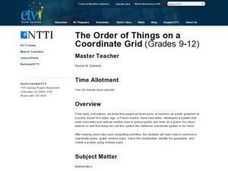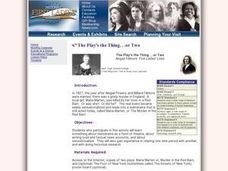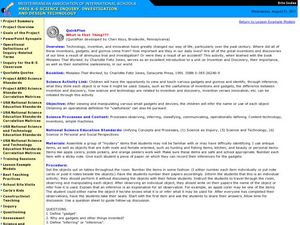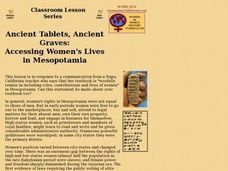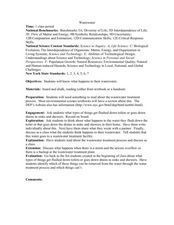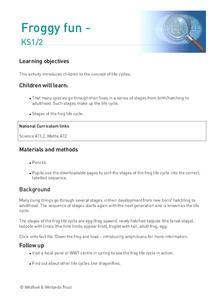Curated OER
Student Designed Investigations Part 3 – Collecting Data and Drawing Conclusions
Learners explore how living things adapt to their environment. In this science lesson, students conduct scientific investigations to examine animal adaptations.
Curated OER
What's for Dinner?
Students investigate the dietary habits of living organisms by creating a model food chain. In this food web lesson, students define several food chain vocabulary words such as omnivore, carnivore and herbivore. Students utilize...
Curated OER
The Order of Things on a Coordinate Grid
High schoolers are able to identify ordered pairs on coordinate plane, and graph points on a coordinate plane. They are able to write an ordered pair for each of the points on a graph, and create a design or picture using ordered pairs.
Curated OER
Let's Heat Things Up!
Students build and evaluate simple models to understand the greenhouse effect. They explore the role of increased greenhouse gas concentration in global warming, and the implications of global warming theory for engineers, themselves...
Curated OER
What Lives in the Forest?
Students investigate nearby forests and record their interactions with trees as well as wild life. For this ecology lesson, students read the book, In the Woods: Who's Been Here?, and attend class observational field trips through their...
Curated OER
Present Simple and Plural Activities - Things We Do At School...
In this present simple verb tense online activity, students enter the proper verb tense of the underlined words in 13 sentences. They fill in the verbs from a word bank in the next 10 sentences, enter either don't or doesn't in the next...
National First Ladies' Library
The Play's the Thing...or Two
Students explore melodram as a form of theatre. They write about lucid and factual news accounts and about sensationalism. Students gain experience in relating one time period with another and with doing historical research.
Curated OER
How Do Things Fall?
Students study forces by examining the force of gravitational attraction. They observe how objects fall and measure the force of gravitational attraction upon objects. Students discover that, since gravitational constants are different...
Curated OER
What Is That Thing?
Could your class identify an old-fashioned can opener? What about a rotary phone, or a VCR? Learners take a look at several gadgets and devices to infer the name and purpose of each item.
Curated OER
Big Things: Public Symbols in Canada
Eighth graders explore the concept of regional diversity. They examine factors that influence perceptions of identity at the level of community, region, and nation. They contemplate representation issues with respect to challenging...
Curated OER
Energy and Mass-Same Things But Different!
In this energy and mass worksheet, students read about Einstein's formula, E=mc2 and they solve six problems. They convert from different energy units to different mass units using a given formula.
Curated OER
Living in Extreme Environments: Havens on the Deep Sea Floor
Students identify the characteristics of an extreme environment in the deep ocean and consider what organisms need to survive in these elements. They research sampling and data collection methods in this environment.
Curated OER
Ancient Tablets, Ancient Graves: Accessing Women's Lives in Mesopotamia
High schoolers explore the role of women in ancient Mesopotamia. Several excerpts from the Mesopotamian cuneiform tablets and artifacts are analyzed to determine the treatment, rights, and powers of women in this era.
Curated OER
The Sun in Our Lives
Third graders identify the different parts of the sun. In this astronomy lesson plan, 3rd graders examine how the sun's energy drive life processes on Earth. They construct a model of a solar system using large rolls of toilet paper.
Curated OER
Seeing Things From the Someone Else's Point of View
Students examine the cultural trait of sharing, trying to view it from the point of view of someone in another culture. They question what we gain from trying to see the world from the perspective of another person or culture and...
Curated OER
Blubber Gloves
The ways that animals adapt to their environments is quite remarkable. In this life science lesson plan, fifth graders take a look at some of the ways that aquatic animals that live in Arctic or Antarctic waters survive. They perform an...
Curated OER
Are You One Of Us?
Students discover how to classify things based on their similarities and differences. Students give the characteristics of insects and create a classification list. Given examples of various types of insects, students classify them...
Wild BC
Carbon - The Short and the Long
For this complex game about the carbon cycle, the playing field is divided into air, living, and earth zones. Children are assigned to be either plants or animals, and collect carbon tokens as they proceed from zone to zone. While the...
Curated OER
Pick a Pet
Students design informational materials to educate people on the importance of matching a new pet to the family's lifestyle and living arrangements. Students use critical thinking skills to make a decision on the appropriate choice for a...
Science Matters
Island Fox Outreach
Off the coast of California lives a wild animal called the Island Fox. Experts discuss the importance of the Island Fox to the Channel Islands and the balance the fox creates within its ecosystem. The lesson concludes with a reading of...
Curated OER
Prairie Predator and Prey
Fifth graders brainstorm a list of animals that live on the prairie, and classify them as predators and prey. They conduct interviews where they ask the animals what they need to look out for to sustain life on the prairie.
Curated OER
Wastewater
High schoolers discuss what happens to their wastewater. They read about the wastewater treatment process. Students are asked what types of things get flushed down toilets or goes down drains in sinks and showers. They are taught what...
Curated OER
The Great Kapok Tree by Lynne Cherry
With The Great Kapok Tree, by Lynne Cherry as the hook learners discuss the rainforest, the animals that live there, and conservation efforts. Then, students write a letter to the man in the story asking him not to cut down the Kapok...
Curated OER
Froggy Fun
Students are introduced to the concept of life cycles. They discover how many species go through their lives in a series of stages from birth or hatching to adulthood. Such stages make up the life cycle. Students investigate the life...
Other popular searches
- Classify Living Things
- Grouping Living Things
- Basic Needs of Living Things
- Classifying Living Things
- Classification Living Things
- Needs of Living Things
- Non Living Things
- Classifying Living Organisms
- Five Kingdoms of Living Things
- Kingdoms of Living Things
- What Living Things Need
- Living Organisms Biology




